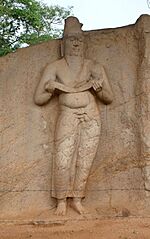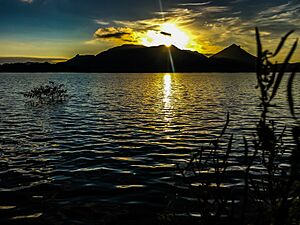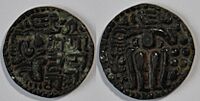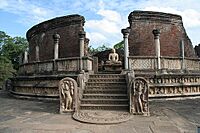Kingdom of Polonnaruwa facts for kids
Quick facts for kids
Kingdom of Polonnaruwa
පොළොන්නරුව රාජධානිය
Polonnaruwa Rājādhaniya |
|||||||||||||
|---|---|---|---|---|---|---|---|---|---|---|---|---|---|
| 1055–1232 | |||||||||||||

Kingdom of Polonnaruwa before 1153 Principality of Maya Rata Principality of Ruhuna
|
|||||||||||||
| Capital | Vijayarajapura | ||||||||||||
| Common languages | Sinhala | ||||||||||||
| Religion | Theravada Buddhism | ||||||||||||
| Demonym(s) | Sinhala: පොළොන්නරු, romanized: Polańaru | ||||||||||||
| Government | Monarchy | ||||||||||||
| Monarch | |||||||||||||
|
• 1055-1111
|
Vijayabahu I | ||||||||||||
|
• 1153-1186
|
Parakramabahu I | ||||||||||||
|
• 1187-1196
|
Nissanka Malla | ||||||||||||
| Historical era | Polonnaruwa period | ||||||||||||
|
• Established
|
1055 | ||||||||||||
|
• Disestablished
|
1232 | ||||||||||||
| Currency | Coins | ||||||||||||
|
|||||||||||||
| Today part of | Sri Lanka India |
||||||||||||
The Kingdom of Polonnaruwa (Sinhala: පොළොන්නරුව රාජධානිය, romanized: Polonnaruwa Rājādhaniya) was a powerful Sinhalese kingdom in Sri Lanka. It ruled the island and some areas overseas from 1070 to 1232. This kingdom grew its power abroad especially during the time of Parakramabahu the Great.
The kingdom even had a strong presence in South India. This happened after it got involved in a civil war there. During this war, a region called Pandya Nadu came under the control of Polonnaruwa's army. Even places like Tondi and Pasi, which were part of the Chola empire, were ruled by Polonnaruwa's military. The city of Rameshwaram was also under their control until 1182. The kingdom even made its own coins, called Kahapana, in these areas.
Even though kings like Parakramabahu brought good times, the kingdom often faced problems. There was a lot of fighting among royal families, especially between the Pandya and Kalinga groups. This allowed army generals to become very powerful. Generals like Ayasmanta and Lokissara would often take control and put their chosen rulers on the throne. For example, Queen Lilavati ruled three times, each time with the help of different generals. This constant power struggle weakened the kingdom. As a result, the Pandyans and Cholas from the North often attacked and raided the kingdom.
In 1212, a rival named Parakrama Pandyan took over the capital with help from the Pandyans. Just three years later, Kalinga Magha invaded with 24,000 men. He captured the ruler and attacked Polonnaruwa. The ancient book Mahavamsa says that Polonnaruwa was destroyed and many people were killed. This led to a huge move of people to the South, ending a 1500-year-old civilization in the Rajarata area.
After Magha took the capital, many local leaders and nobles started fighting back. They built forts in different places to resist the invaders. This led to the rise of Vijayabahu III. He was the ruler of a fort called Dambadeniya. He brought the region of Maya Rata under his control and reduced Magha's power. In 1232, he started the kingdom of Dambadeniya. This marked the beginning of a new period in Sri Lankan history.
Contents
A Look at Polonnaruwa's Past
After ruling for over 1,400 years, the Kingdom of Anuradhapura fell in 1017. The Chola King Rajaraja and his son Rajendra captured King Mahinda V. They took him to Tamil Nadu as a prisoner, where he died in 1029. The Cholas then moved the capital from Anuradhapura to Polonnaruwa. They ruled for about 53 years. The Cholas called Polonnaruwa "Jananathapuram."
King Vijayabahu I (also known as Kitti) eventually defeated the Cholas. He brought back the Sinhalese monarchy. Polonnaruwa was always an important place. It controlled the river crossings of the Mahaveli River that led to Anuradhapura.
Three years after taking back Anuradhapura, Vijayabahu got ready for possible attacks. He moved the capital from Anuradhapura to Polonnaruwa, which was easier to defend. After winning at Polonnaruwa, Vijayabahu faced more rebellions. This delayed his coronation, which finally happened in 1072 or 1073. This was eighteen years after he became king in Ruhuna. Polonnaruwa was renamed Vijayarajapura and became the new capital. The coronation was held in a special palace in Anuradhapura. Vijayabahu married Lilavati, a princess from Kanauj. He later married Tilokasundari, a princess from Kalinga, to make his kingdom stronger.
The Rise of Parakramabahu I
When Vijayabahu died, there was a fight over who would be the next king. Parakramabahu I became king only after winning a war against other people who wanted the throne.
First, he tried to secretly work with Gajabahu's army chief, but this didn't work. Then, he sent his army to capture Rajarata. However, he met Manabaraha, who joined forces with Gajabahu. Despite this setback, Parakramabahu still captured Rajarata. Gajabahu's army became weak, and he also had to fight Manabharana. Gajabahu later announced that he had given Rajarata to Parakramabahu. Manabharana was also defeated.
After these conflicts, Parakramabahu I united the three main regions: Rohana, Malaya, and Rajarata. He declared the entire island as the Polonnaruwa kingdom. His time as king saw the kingdom grow a lot. He led attacks and large invasions against his enemies. He even invaded the kingdom of Ramanna (now lower Burma). This was because they had done unfriendly things, like kidnapping a princess. In this invasion, he captured the city of Bassein in Burma.
After Parakramabahu's Reign
After Parakramabahu died, Vijayabahu II became king. He invited Nissanka Malla to visit the country and take the throne. However, Vijayabahu II was killed by an invader named Mahinda VI.
Nissanka Malla then killed Mahinda VI. He said he was the rightful heir to the throne, being a descendant of Vijaya Singha.
Life in the Kingdom
Farming and Water Systems
Starting with King Parakramabahu I, there was a huge focus on irrigation. He famously said:
Let no water drop that falls from the rain make it to the sea without being useful to the mankind
To achieve this, many large tanks were built. Some of his most famous projects include the Parakrama Samudra and the Giritale tank. These water systems were even better than those built during the Anuradhapura period. Older dams were also repaired and improved during this time.
People and Languages
Most people in the kingdom were Sinhalese. The Sinhalese language was spoken by everyone. There are records of people from Cambodia settling in an area called Kambojavâsaĺa. The Khmer script was even used to write some Pali texts, like a version of the Mahavamsa.
Trade and Money
Most trading happened through important seaports like Kalpitiya, Halaavatha (Chilaw), and Colombo.
Coins Used for Trade
The coins used were mostly made of copper. They often had the image of the ruler on them. Gold coins also existed but became rare towards the end of Parakramabahu I's rule. This might have been due to money problems. The coins of Polonnaruwa looked a lot like those from the Chola kingdom. Some coins found in South India, called Setu coins, might also be from Polonnaruwa.
Trade with Chinese kingdoms was very active during this time. Coins from the Song dynasty have been found all over Polonnaruwa. In the areas Polonnaruwa controlled in South India, the Kahapana currency was used.
Amazing Buildings and Technology
The ancient Sinhalese people were very skilled in technology. The irrigation systems in Polonnaruwa were similar to those in Anuradhapura but even more advanced. As James Emerson Tennent wrote, they were "unsurpassed by any other people in the world." Building huge dams and artificial lakes, like the Parakrama Samudra, needed advanced technology and unique building methods.
The Vatadage Temple
The Vatadages were round temple structures built to protect small stupas. While they existed before, they reached their best form during the Polonnaruwa period. The Polonnaruwa Vatadage is seen as the "ultimate creation" of all Vatadages. This structure has two stone platforms with beautiful carvings. You enter the lower platform from the north. The second platform has four entrances, one for each direction. This upper platform has a brick wall around the stupa. Four Buddha statues sit around the stupa, facing the entrances. There were also three rows of stone columns, likely to hold up a wooden roof. The whole building is covered in stone carvings. Some carvings, like the "sandakada pahanas" (moonstones), are considered the best examples of their kind.
Nissanka Malla's Buildings
King Nissanka Malla (1187-1197) built the Hatedage and Nissanka Latha Mandapaya. These were made to store important relics. The Hatadage is said to have held relics like the Buddha's Tooth and his Rice Bowls. Old writings say it was built in sixty hours. Since "Hata" means sixty in Sinhala and "Dage" means relic shrine, it might have been named Hatadage to remember this quick building feat. Another idea is that it held sixty relics.
Nissanka Malla built many structures, often trying to make them grander than those built by Parakramabahu I. He even built a statue of himself.
Polonnaruwa's Military Power (1153–1186)
King Parakramabahu organized the kingdom's military. It included main armies and extra forces made up of other Buddhist groups.
Ground Forces
The ground forces of Polonnaruwa under Parakramabahu had several parts. The ancient text Culawamsa suggests the army might have had as many as 100,000 soldiers around the 1140s. The main armies were led by generals like Rakkha. Other important generals were sent to help Rakkha fight against rebels. The extra units were often made up of Buddhist minorities and tribal groups.
The first navy was created in 1165. This navy was used for the invasion of Burma.
The Kingdom's Decline
After the death of King Kalinga Lokeshvara, his son Vira Bahu I became king. However, he was killed by a military commander. This led to a period where the military had a lot of power. Then, Vikramabahu I became king but was killed by a relative. The military took control again and arrested the new king. The military became very powerful, even pushing out the royal family. King Anikanga asked the Cholas for help. An army was sent, and Anikanga became king. But he and the army commander were killed after only three months.
The military took power again, and Lilavati was put on the throne. She was later removed by a military commander named Lokissara. However, the Royal Army, who were rivals to Lokissara, killed him.
The End of Lilavati's Rule
Parakrama Pandyan II from the Pandyan Kingdom invaded Polonnaruwa. This forced Queen Lilavati to leave. Parakrama Pandyan II became king and ruled from 1212 to 1215 CE. He was then removed by the invader, Kalinga Magha, who later started the Jaffna kingdom. Kalinga Magha ruled for 21 years until he was also driven out of Polonnaruwa in 1236 by an invasion from the south.
A New Beginning
After defeating and removing Kalinga Magha from Polonnaruwa, Vijayabahu III moved the capital to Dambadeniya. He started a new royal family called the House of Sri Sanga Bo.
Religion in Polonnaruwa
Buddhism remained the main religion during the Polonnaruwa era. The kings of Polonnaruwa often exchanged religious gifts with other Theravada Buddhist kings from places like Siam, Burma, and Kampuchea. Before the Buddhist kings took over, Hinduism had a strong influence due to the Cholas. You can see this in the removal of cow shapes from moonstones in Polonnaruwa and the presence of Shiva temples. After the Chola rule, many Buddhist temples were repaired by Vijayabahu I and Parakramabahu I.
Buddhism's Strong Presence
The main type of Buddhism practiced in Polonnaruwa was the traditional school of Buddhism. After some religious changes in Burma, many monks there followed the lead of the monks in Polonnaruwa.
Buddhism Spreads to Cambodia
The Khmer King Jayavarman VII sent his son Tamalinda to Polonnaruwa. He wanted his son to become a Buddhist monk and study Theravada Buddhism. Tamalinda then went back to Angkor and helped spread the Theravada Buddhist traditions he had learned.
Images for kids
See also
- Polonnaruwa period
- List of Sri Lankan monarchs
- Kalinga (historical region)
- Siri Parakum













